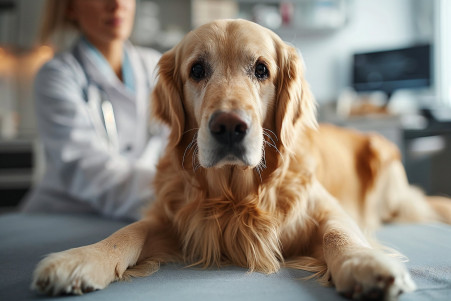Do Spayed Dogs Have Heat Cycles? Phantom Heat Cycles Explained
27 March 2024 • Updated 25 March 2024

Spaying is supposed to eliminate heat cycles in female dogs, but some pet parents have noticed signs that seem to indicate their spayed dogs are still experiencing something like a heat cycle. While spayed dogs can't have heat cycles because the surgery removes the ovaries that produce the hormones that drive the cycle, there are other medical issues that can cause dogs to show signs that could be confused with a heat cycle.
This article will cover the potential reasons for phantom heat symptoms in spayed dogs and how veterinarians work to diagnose and treat them. By reviewing information from animal reproductive biology and clinical veterinary research, we'll help you understand the nuances of this issue. This will provide you with the knowledge you need to better understand your spayed dog's health and behavior.
Do spayed dogs go into heat?
What Is Ovarian Remnant Syndrome?
Ovarian remnant syndrome is the most common cause of heat-like symptoms in spayed dogs. It occurs when small pieces of ovarian tissue are inadvertently left behind during the spay (ovariohysterectomy) surgery. This ovarian tissue then continues to produce estrogen and progesterone, which causes the dog to display signs of a heat cycle, such as a swollen vulva, bloody vaginal discharge, and attracting male dogs.
Risk factors for ovarian remnant syndrome include the dog's breed, age at the time of spaying, and the surgical technique used. Improper placement of clamps or ligatures, poor visualization during surgery, or accidental dropping of ovarian tissue into the abdomen can all contribute. Some breeds may also be more susceptible to developing ovarian remnants.
Ovarian remnant syndrome is diagnosed through hormone level testing, which can detect high levels of estrogen and progesterone. Vaginal cytology can also be used to look for changes in cells, and imaging studies, such as ultrasound, can be used to look for remnant ovarian tissue. Early and accurate diagnosis is important because ovarian remnants can lead to complications, such as granulosa cell tumors, if they are not treated. It is also important to diagnose the condition accurately so that the appropriate treatment can be planned.
How Ovarian Remnant Syndrome Is Treated
The only treatment for ovarian remnant syndrome is surgery to remove the remaining ovarian tissue. The Merck Veterinary Manual explains that this surgery is usually done a few weeks after the initial spay. Laparoscopy and other minimally invasive techniques can be used to remove ovarian remnants, as demonstrated by a study published in BMC Veterinary Research. Proper post-operative care and monitoring are important to ensure that the animal heals completely and to prevent the syndrome from recurring.
In cases where surgery is not an option, hormone therapy or medications may be used to manage the symptoms of ovarian remnant syndrome. The AKC Canine Health Foundation explains that the combination of serum anti-Müllerian hormone (AMH) and progesterone can be a better diagnostic tool than other methods. This data can help veterinarians decide on the best course of treatment for each case.
How to Avoid Heat Symptoms in Spayed Dogs
The only way to avoid heat symptoms in female dogs is to have them spayed before their first heat cycle, which is generally before they are 6-7 months old. VCA Animal Hospitals notes that this is the only way to avoid pregnancy. It is important to note that the surgical technique used during the spay is important to ensure that the ovaries and uterus are completely removed, which is necessary to avoid ovarian remnant syndrome.
Veterinarians may use other diagnostic methods, such as hormone tests or imaging, to verify that there is no ovarian tissue left after the surgery. Regular follow-up appointments and monitoring can also help catch any potential issues or complications early.
In some cases, medications or hormones may be used to prevent heat symptoms temporarily, but WagWalking explains that these can have side effects that need to be closely monitored. The best way to make sure your dog lives a long, healthy life is to be a responsible pet owner, which includes having your dog spayed in a timely manner and ensuring that they receive proper post-operative care.
Dealing With Behavioral Changes and Male Dog Attraction
In some cases, dogs can continue to attract male dogs after being spayed due to pheromones that are still present in their system or hormonal imbalances. WagWalking explains that this attraction can last for several weeks to months after the spaying has occurred as the hormones in the dog's body return to normal levels. During this time, dogs can also experience other behavioral changes, such as increased licking and restlessness.
Behavioral management, such as separating the dog from other dogs and providing mental stimulation, can help reduce these symptoms. The Dog Forum explains that excitement and stress can also cause male dogs to mount other dogs. In some cases, a vet may recommend medication or hormone therapy to help regulate the dog's hormones and reduce their behavioral problems.
Research published in PubMed explains that the pheromones in the vaginal secretions of female dogs in heat can cause male dogs to become sexually aroused, even if the female dog has been spayed. It's important to monitor and manage the dog during this time to ensure that they have a successful recovery.
Why Proper Spay Techniques and Post-Op Care Are Important
Spaying is an important part of preventing unwanted litters and lowering the risk of certain health problems in female dogs. VCA Animal Hospitals explains that spaying via ovariohysterectomy, which removes the entire female reproductive tract, is the most common and recommended method. It’s important that the surgery is done correctly and that the ovaries and uterus are completely removed to ensure the procedure is a success.
Veterinarians need to make sure they’re using best practices and following guidelines to lower the risk of complications, including ovarian remnant syndrome. Paws and More Vet says that female dogs that have been desexed are generally happier, more relaxed, and less aggressive because the desire to mate has been removed. Regular check-ups and monitoring can help catch and deal with any issues or concerns that arise after the surgery.
Being a responsible pet owner means knowing the pros and cons of spaying and making sure to provide the right care after the surgery. By making sure that spaying is done correctly and that post-op care is thorough, pet owners can help make sure that their spayed dogs are healthy and happy in the long run.
Conclusion: How to Make Sure Your Spayed Dog Is Healthy and Happy
Spaying is a safe and effective way to prevent heat cycles and unwanted pregnancies in female dogs. While the symptoms of heat are rare in dogs that have been spayed, ovarian remnant syndrome and other issues can still occur. It’s important to catch these issues early and get the right treatment, which often involves surgery to remove any ovarian tissue that has been left behind.
Regular vet visits and a commitment to the aftercare plan can help ensure that your dog recovers well and enjoys good health in the years to come. By learning about the risks and taking steps to address them, you can help ensure that your dog enjoys a happy and healthy life after being spayed.


